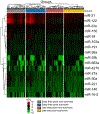A novel microRNA-based prognostic model outperforms standard prognostic models in patients with acetaminophen-induced acute liver failure
- PMID: 33857547
- PMCID: PMC10668489
- DOI: 10.1016/j.jhep.2021.03.013
A novel microRNA-based prognostic model outperforms standard prognostic models in patients with acetaminophen-induced acute liver failure
Abstract
Background & aims: Acetaminophen (APAP)-induced acute liver failure (ALF) remains the most common cause of ALF in the Western world. Conventional prognostic models, utilising markers of liver injury and organ failure, lack sensitivity for mortality prediction. We previously identified a microRNA signature that is associated with successful regeneration post-auxiliary liver transplant and with recovery from APAP-ALF. Herein, we aimed to use this microRNA signature to develop outcome prediction models for APAP-ALF.
Methods: We undertook a nested, case-control study using serum samples from 194 patients with APAP-ALF enrolled in the US ALF Study Group registry (1998-2014) at early (day 1-2) and late (day 3-5) time-points. A microRNA qPCR panel of 22 microRNAs was utilised to assess microRNA expression at both time-points. Multiple logistic regression was used to develop models which were compared to conventional prognostic models using the DeLong method.
Results: Individual microRNAs confer limited prognostic value when utilised in isolation. However, incorporating them within microRNA-based outcome prediction models increases their clinical utility. Our early time-point model (AUC = 0.78, 95% CI 0.71-0.84) contained a microRNA signature associated with liver regeneration and our late time-point model (AUC = 0.83, 95% CI 0.76-0.89) contained a microRNA signature associated with cell-death. Both models were enhanced when combined with model for end-stage liver disease (MELD) score and vasopressor use and both outperformed the King's College criteria. The early time-point model combined with clinical parameters outperformed the ALF Study Group prognostic index and the MELD score.
Conclusions: Our findings demonstrate that a regeneration-linked microRNA signature combined with readily available clinical parameters can outperform existing prognostic models for ALF in identifying patients with poor prognosis who may benefit from transplantation.
Lay summary: While acute liver failure can be reversible, some patients will die without a liver transplant. We show that blood test markers that measure the potential for liver recovery may help improve identification of patients unlikely to survive acute liver failure who may benefit from a liver transplant.
Keywords: Regeneration; biomarker; cell-death; outcome prediction.
Copyright © 2021 European Association for the Study of the Liver. Published by Elsevier B.V. All rights reserved.
Conflict of interest statement
Conflict of interest The authors declare no conflicts of interest that pertain to this work. Please refer to the accompanying ICMJE disclosure forms for further details.
Figures





References
-
- O’Grady JG, Schalm SW, Williams R. Acute liver failure: redefining the syndromes. Lancet 1993;342:273–275. - PubMed
-
- Bernal W, Hyyrylainen A, Gera A, Audimoolan VK, McPhail MJW, Auzinger G, et al. Lessons from look-back in acute liver failure? A single centre experience of 3300 patients. J Hepatol 2013;59:74–80. - PubMed
-
- O’Grady JG, Alexander GJ, Hayllar KM, Williams R. Early indicators of prognosis in fulminant hepatic failure. Gastroenterology 1989;97:439–445. - PubMed
Publication types
MeSH terms
Substances
Grants and funding
LinkOut - more resources
Full Text Sources
Other Literature Sources

